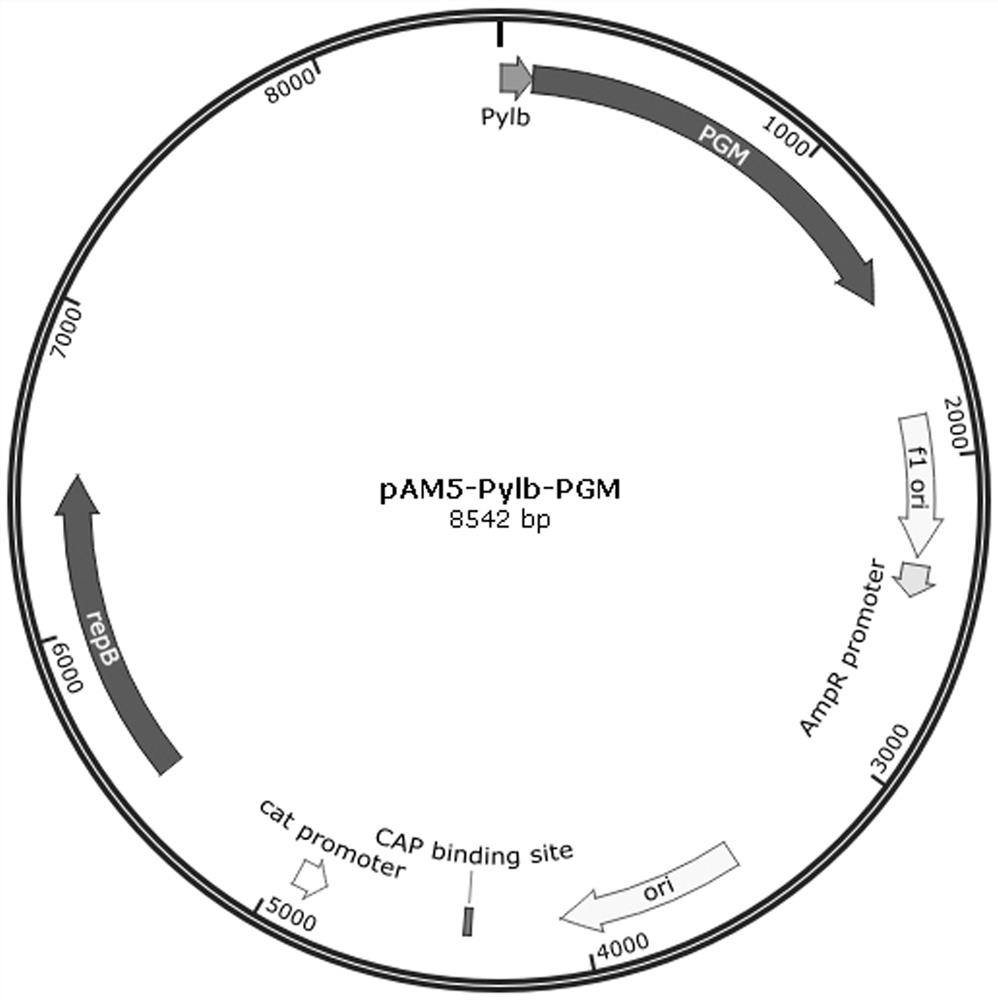Bacillus subtilis genetically-engineered bacteria for producing tagatose and method for preparing tagatose
A technology of Bacillus subtilis and genetically engineered bacteria, applied in the field of bioengineering, can solve the problems of cumbersome purification steps, difficult recycling, and low utilization rate of enzymes
- Summary
- Abstract
- Description
- Claims
- Application Information
AI Technical Summary
Problems solved by technology
Method used
Image
Examples
Embodiment 1
[0054] Embodiment 1: Construction of Bacillus subtilis recombinant strain SCK8
[0055] (1) Construction of recombinant integration vector pSS-upp-FR
[0056] According to the KEGG database derived from Bacillus subtilis Bacillus subtilis 168 uracil phosphoribosyltransferase encoding gene upp Gene sequence (NCBI-ProteinID: NP_391570), designed primers, and obtained by PCR amplification upp The 500 bp upstream homologous fragment and the 500 bp downstream homologous fragment of the gene are joined by simple cloning (You, C., Zhang, X. Z., & Zhang, Y. H. (2012). Simple cloning via direct transformation of PCR product (DNA Multimer) to Escherichia coli and Bacillus subtilis . Appl. Environ. Microbiol., 78 (5), 1593-1595. doi:10.1128 / AEM.07105-11) was constructed into the integration vector pSS to obtain the recombinant integration vector pSS-upp-FR.
[0057] (2) Construction of Bacillus subtilis recombinant strain SCK8
[0058] Preparation of Bacillus subtilis ...
Embodiment 2
[0062] Example 2 Construction of Bacillus subtilis recombinant strain SCK8-ST1
[0063] (1) Construction of recombinant integration vector pSS-amyE-FR
[0064] According to the KEGG database derived from Bacillus subtilis Bacillus subtilis 168 genes encoding α-amylase amyG Gene sequence (NCBI-ProteinID: NP_388186), designed primers, and obtained by PCR amplification amyGThe 500 bp upstream homologous fragment and the 500 bp downstream homologous fragment of the gene are joined by simple cloning (You, C., Zhang, X. Z., & Zhang, Y. H. (2012). Simple cloning via direct transformation of PCR product (DNA Multimer) to Escherichia coli and Bacillus subtilis . Appl. Environ. Microbiol., 78 (5), 1593-1595. doi:10.1128 / AEM.07105-11) was constructed into the integration vector pSS to obtain the recombinant integration vector pSS-amyE-FR.
[0065] (2) Construction of Bacillus subtilis recombinant strain SCK8-ST1
[0066] Prepare Bacillus subtilis strain SCK8 supercompete...
Embodiment 3
[0070] Example 3 Construction of Bacillus subtilis recombinant strain SCK8-ST2
[0071] (1) Construction of recombinant integration vector pSS-spoIIAC-FR
[0072] According to the KEGG database derived from Bacillus subtilis Bacillus subtilis 168 sporulation RNA polymerase σ F factor coding gene spoIIAC Gene sequence (NCBI-ProteinID: NP_390226), designed primers, and obtained sporulation by PCR amplification spoIIAC The 500 bp upstream homologous fragment and the 500 bp downstream homologous fragment of the gene are joined by simple cloning (You, C., Zhang, X. Z., & Zhang, Y. H. (2012). Simplecloning via direct transformation of PCR product (DNA Multimer) to Escherichia coli and Bacillus subtilis . Appl. Environ. Microbiol., 78 (5), 1593-1595. doi:10.1128 / AEM.07105-11) was constructed into the integration vector pSS to obtain the recombinant integration vector pSS- spoIIAC -FR.
[0073] (2) Construction of Bacillus subtilis recombinant strain SCK8-ST2
[00...
PUM
 Login to View More
Login to View More Abstract
Description
Claims
Application Information
 Login to View More
Login to View More - R&D
- Intellectual Property
- Life Sciences
- Materials
- Tech Scout
- Unparalleled Data Quality
- Higher Quality Content
- 60% Fewer Hallucinations
Browse by: Latest US Patents, China's latest patents, Technical Efficacy Thesaurus, Application Domain, Technology Topic, Popular Technical Reports.
© 2025 PatSnap. All rights reserved.Legal|Privacy policy|Modern Slavery Act Transparency Statement|Sitemap|About US| Contact US: help@patsnap.com



